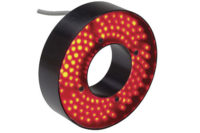Lighting and More

Getting a good image can be critical to getting a faster, more reliable and simpler system for both individual photosensors and vision systems. This has been emphasized recently in Vision & Sensors in articles by myself and others as well as in recent blogs by Ned Lecky and John Nagle.
Optics can do many jobs. A primary one is to compensate for changes that can occur over time in lighting intensity, materials characteristics and position. Eliminating false positives and false negatives (or interferences), usually by optics and perhaps aided by appropriate electronics and software, is a primary design objective. Increasing optical contrast (or signal/noise) usually works to increase reliability and reduce complexity while getting the job done.
Here we will look at combined optics and electronics that solved several problems. An overview of broader categories of optical tools for details and examples will follow in later blogs.
Eliminating Effects of Variations in Optics and Products
Let us talk about one system that we developed and installed for 1 mil defect detection (in 2 mil coating on 10 mil wire) during extrusion-coating.
To detect smaller defects, we want to detect smaller changes in intensity. The intensity of ordinary tungsten filament light sources (with 110 Volts, 60 cycles/sec) fluctuates about 10% to 15% from the thermal heating & cooling (of course, we bench-checked this), and tungsten light source emission decreases with time. One solution often used is to provide an electronically very well controlled light source that produces constant intensity or a well controlled high-frequency alternating voltage.
A simpler and less expensive alternative was chosen, using a single light source and a bifurcated fiber optic bundle (that is, light goes in one end of the fiber bundle and the illuminated bundle is split then into two fiber optic bundles: the cable looks like a Y with the light input at the bottom of the Y) More on optics. The two output fibers, with light, illuminate two different areas of the moving coated wire. Two detectors are used to detect the light from each of the two illuminated areas, and the difference signal is used for defect detection. Changes in illumination over large areas are the same for both photo-detectors: the difference signal cancels out the simultaneous fluctuations.
In addition, the optical properties of the material can change with time: the color or surface texture can change slowly without changing the product’s acceptability. This differential detection eliminates that as a problem as well.
More Lighting information to follow in the next blog post.
Looking for a reprint of this article?
From high-res PDFs to custom plaques, order your copy today!



